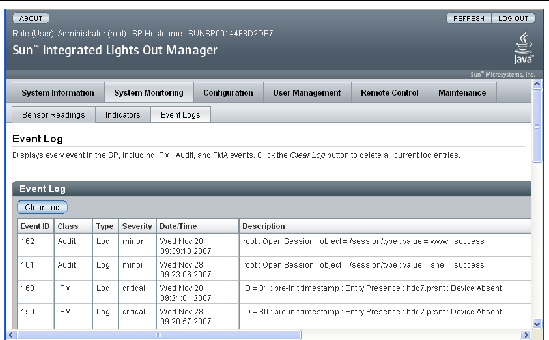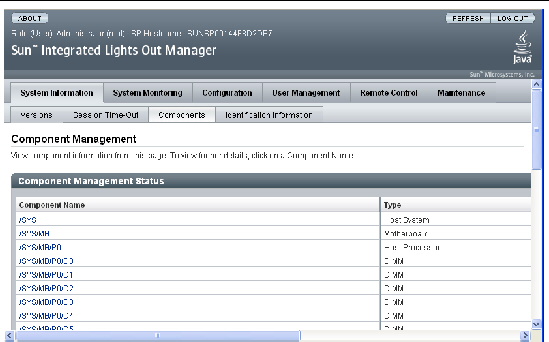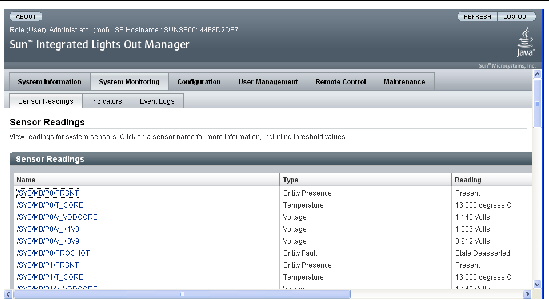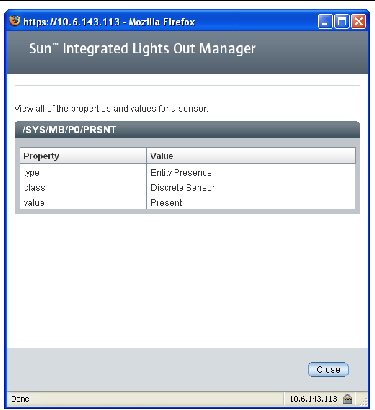| A P P E N D I X D |
|
Using the ILOM Service Processor GUI to View System Information |
This appendix contains information about using the Integrated Lights Out Manager (ILOM) Service processor (SP) GUI to view monitoring and maintenance information for your server.
For more information on using the ILOM SP GUI to maintain the server (for example, configuring alerts), refer to the Integrated Lights Out Manager Administration Guide.
To make a serial connection to the SP:
1. Connect a serial cable from the RJ-45 Serial Management port on server to a terminal device.
2. Press ENTER on the terminal device to establish a connection between that terminal device and the ILOM SP.
| Note - If you are connecting to the serial port on the SP before it has been powered up or during its power-up sequence, you will see boot messages. |
The service processor eventually displays a login prompt. For example:
SUNSP0003BA84D777 login:
The first string in the prompt is the default host name for the ILOM SP. It consists of the prefix SUNSP and the MAC address of the ILOM SP. The MAC address for each ILOM SP is unique.
3. Log in to the SP and type the default user name, root, with the default password, changeme.
Once you have successfully logged in to the SP, it displays its default command prompt.
4. To start the serial console, type the following commands:
To exit console mode and return to the service processor, type (escape/shift 9)
Events are notifications that occur in response to some actions. The IPMI system event log (SEL) provides status information about the server’s hardware and software to the ILOM software, which displays the events in the ILOM web GUI. To view event logs:
1. Log in to the SP as Administrator or Operator to reach the ILOM web GUI:
a. Type the IP address of the server’s SP into your web browser.
The Sun Integrated Lights Out Manager Login screen is displayed.
b. Type your user name and password.
When you first try to access the ILOM SP, you are prompted to type the default user name and password. The default user name and password are:
Default user name: root
Default password: changeme
2. From the System Monitoring tab, select Event Logs.
The System Event Logs page is displayed. See FIGURE D-1 for a page that shows sample information.
FIGURE D-1 System Event Logs Page

3. Select the category of event that you want to view in the log from the drop-down list box.
You can select from the following types of events:
After you have selected a category of event, the Event Log table is updated with the specified events. The fields in the Event Log are described in TABLE D-1.
|
The day and time the event occurred. If the Network Time Protocol (NTP) server is enabled to set the SP time, the SP clock will use Universal Coordinated Time (UTC). For more information about time stamps, see Interpreting Event Log Time Stamps. |
|
|
The name of a component for which an event was recorded. The sensor name abbreviations correspond to these components: |
|
4. To clear the event log, click the Clear Event Log button.
A confirmation dialog box is displayed.
5. Click OK to clear all entries in the log.
6. If the problem with the server is not evident after viewing ILOM SP logs and information, continue with Running SunVTS Diagnostic Tests.
The system event log time stamps are related to the service processor clock settings. If the clock settings change, the change is reflected in the time stamps.
When the service processor reboots, the SP clock is set to Thu Jan 1 00:00:00 UTC 1970. The SP reboots as a result of the following:
After an SP reboot, the SP clock is changed by the following events:
Depending on the component you select, information about the manufacturer, component name, serial number, and part number can be displayed. To view replaceable component information:
1. Log in to the SP as Administrator or Operator to reach the ILOM web GUI:
a. Type the IP address of the server’s SP into your web browser.
The Sun Integrated Lights Out Manager Login screen is displayed.
b. Type your user name and password.
When you first try to access the ILOM Service Processor, you are prompted to type the default user name and password. The default user name and password are:
Default user name: root
Default password: changeme
2. From the System Information tab, select Components.
The Replaceable Component Information page is displayed. See FIGURE D-2.
FIGURE D-2 Replaceable Component Information Page

3. Select a component from the drop-down list.
Information about the selected component is displayed.
4. If the problem with the server is not evident after viewing replaceable component information, continue with Running SunVTS Diagnostic Tests.
This section describes how to view the server temperature, voltage, and fan sensor readings.
For a complete list of sensors, see Appendix D.
For more information on sensors, see the ILOM Supplement documentation for Sun Fire X4140, X4240, and X4440 Servers.
1. Log in to the SP as Administrator or Operator to reach the ILOM web GUI:
a. Type the IP address of the server’s SP into your web browser.
The Sun Integrated Lights Out Manager Login screen is displayed.
b. Type your user name and password.
When you first try to access the ILOM Service Processor, you are prompted to type the default user name and password. The default user name and password are:
Default user name: root
Default password: changeme
2. From the System Monitoring tab, select Sensor Readings.
The Sensor Readings page is displayed. See FIGURE D-3.
FIGURE D-3 Sensor Readings Page

3. Click the Refresh button to update the sensor readings to their current status.
4. Click a sensor to display its thresholds.
A display of properties and values appears. See the example in FIGURE D-4.
FIGURE D-4 Sensor Details Page

5. If the problem with the server is not evident after viewing sensor readings information, continue with Running SunVTS Diagnostic Tests.
Copyright © 2010, Oracle and/or its affiliates. All rights reserved.